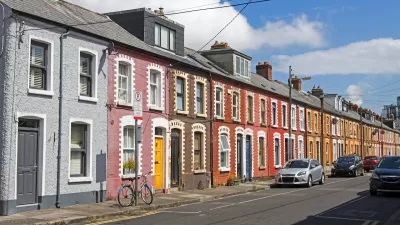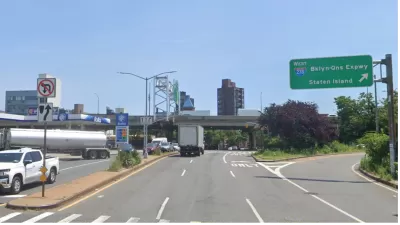Before moving to New York, I'd viewed street design through a fairly simple lens: narrow streets good, wide streets bad. By and large, I still hold this view. But after living here for a few months, I have learned that not all wide streets are equally bad. The wide roads of the South are generally terrible, but New York has made some of its wide streets a bit more pedestrian-friendly. To see why, go to Google Street View and examine three addresses: 5019 U.S. 23 in Chamblee, Georgia, 770 Eastern Parkway in Brooklyn's Crown Heights neighborhood, and 107-43 Queens Boulevard in my current Queens neighborhood of Forest Hills.
Before moving to New York, I'd viewed street design through a fairly simple lens: narrow streets good, wide streets bad. By and large, I still hold this view. But after living here for a few months, I have learned that not all wide streets are equally bad. The wide roads of the South are generally terrible, but New York has made some of its wide streets a bit more pedestrian-friendly. To see why, go to Google Street View and examine three addresses: 5019 U.S. 23 in Chamblee, Georgia, 770 Eastern Parkway in Brooklyn's Crown Heights neighborhood, and 107-43 Queens Boulevard in my current Queens neighborhood of Forest Hills.
First look at the Chamblee address. You will see a road that is seven or so lanes wide. There is no median, so the pedestrian has to cross seven lanes at once, obviously a death-defying act. Not surprisingly, pedestrian fatalities and injuries are fairly common on this road (known to everyone but Street View as "Buford Highway"). Other suburban Atlanta streets have medians that are so thin as to be barely usable: for example, if you go to Cobb Parkway and Galleria Parkway in Smyrna, you will see six lanes of traffic, then a median that appears to be about a foot or two wide, then four more lanes of traffic. Would you feel safe standing on that median?
Now go to the Queens Boulevard address. This street appears to be about twelve lanes. But having lived here for a few months, I can say with some certainty that it is less scary to cross. Why? Because every three or four lanes there is a median. So a pedestrian can walk across three lanes of one-way traffic to median A, then to median B, then finally to the other side of the street. Moreover, a couple of the outer lanes are taken up by on-street parking, which means that the pedestrian often has to cross only one or two lanes of speeding traffic at a time rather than three. Because each chunk of the trip is not so long, the street is not as intimidating as the Atlanta-area addresses discussed above.
Finally, go to the Eastern Parkway address. The street itself is twelve lanes wide: three lanes, then six lanes in the middle, and three lanes. But the northern and southern sets of lanes again have on-street parking, thus reducing the amount of car traffic that the pedestrian must contend with. And when the pedestrian crosses the first three lanes, he or she reaches not a tiny concrete median but a "pedestrian mall" (really a median wider than most sidewalks) which is lined with greenery and street trees. After the six-lane main stretch of Eastern Parkway, the pedestrian reaches another pedestrian mall. Thus, our pedestrian not only does not have to cross all twelve lanes at once, but gets to walk in an fairly appealing environment if he or she just wants to be on Eastern Parkway rather than being on both ends of that street. (On the other hand, Eastern Parkway's six-lane middle stretch might be scarier than any one part of Queens Boulevard).
In sum, both Eastern Parkway and Queens Boulevard are far more pedestrian-friendly than Buford Highway, despite being significantly wider. Why? Because both streets use on-street parking to reduce the number of lanes a pedestrian must cross, and use medians and greenery to ensure that pedestrians don't have to cross as many lanes at a time as on Buford Highway. In addition, Eastern Parkway uses its "pedestrian mall" to decorate the street and make it feel more welcoming than the concrete jungle of Queens Boulevard.

Planetizen Federal Action Tracker
A weekly monitor of how Trump’s orders and actions are impacting planners and planning in America.

San Francisco's School District Spent $105M To Build Affordable Housing for Teachers — And That's Just the Beginning
SFUSD joins a growing list of school districts using their land holdings to address housing affordability challenges faced by their own employees.

The Tiny, Adorable $7,000 Car Turning Japan Onto EVs
The single seat Mibot charges from a regular plug as quickly as an iPad, and is about half the price of an average EV.

Seattle's Plan for Adopting Driverless Cars
Equity, safety, accessibility and affordability are front of mind as the city prepares for robotaxis and other autonomous vehicles.

As Trump Phases Out FEMA, Is It Time to Flee the Floodplains?
With less federal funding available for disaster relief efforts, the need to relocate at-risk communities is more urgent than ever.

With Protected Lanes, 460% More People Commute by Bike
For those needing more ammo, more data proving what we already knew is here.
Urban Design for Planners 1: Software Tools
This six-course series explores essential urban design concepts using open source software and equips planners with the tools they need to participate fully in the urban design process.
Planning for Universal Design
Learn the tools for implementing Universal Design in planning regulations.
Smith Gee Studio
City of Charlotte
City of Camden Redevelopment Agency
City of Astoria
Transportation Research & Education Center (TREC) at Portland State University
US High Speed Rail Association
City of Camden Redevelopment Agency
Municipality of Princeton (NJ)






























